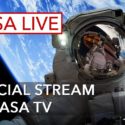
One of the most momentous tests in NASA history is set to launch on Saturday, Sept. 3.
It’s the first, much-anticipated demonstration of the agency’s new 322-foot-tall moon rocket, the Space Launch System (SLS). The launch, originally slated for the morning of Aug. 29, was delayed by an engine issue (a faulty sensor may have been the culprit).
If successful, this critical test mission, called Artemis l, will pave the way for NASA astronauts to return to the moon in late 2025. Ultimately, NASA plans to use this colossal rocket to establish a permanent U.S. presence on and around the moon.
After a 50-year lunar absence, SLS — though hugely expensive, delayed, and tangled in U.S. politics — will enable NASA to restart its human exploration of deep space.
Rain or high winds can often cause launch delays or scrubs. As of Sept. 1, NASA launch managers said the weather looks 60 percent favorable for the SLS rocket to launch on Sept. 3.
Watching the launch is easy
How to watch: NASA will livestream the launch on NASA TV, which you can watch on NASA’s website, on NASA TV’s YouTube Channel, or on NASA’s livestream found just below.
When to watch: The space agency plans to launch the SLS rocket as early as 2:17 p.m. ET on Saturday, Sept. 3 2022. The live coverage starts at 12:15 p.m. ET. NASA has a two-hour time window to blast the rocket into space. Weather often delays rocket launches, so we’ll update this story if NASA is unable to launch on Sept. 3.
What the Artemis l mission will do
-
The uncrewed mission will prove that the SLS rocket can lift the Orion spacecraft (which will eventually carry astronauts) into space and help propel it to the moon. If successful, the rocket will become the most powerful launch vehicle in the world.
-
NASA spaceflight engineers will scrutinize the performance of Orion as it travels through space, loops around the moon a number of times, and then returns to Earth. The mission will last 42 days.
-
Orion will plummet through Earth’s atmosphere and splash down in the Pacific Ocean. This all has to go smoothly and safely: Astronauts will be on the next mission, Artemis ll.
Want more science and tech news delivered straight to your inbox? Sign up for Mashable’s Top Stories newsletter today.

Credit: NASA Langley Research Center
Go to Source
Author:
